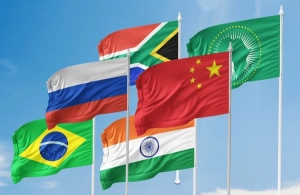The global economic map is shifting, with the world’s economic axis now tilting southward and eastward and the rise of the BRICS bloc − comprising Brazil, Russia, India, China, and South Africa − marking the emergence of new centers of growth, which have long been dominated by Western countries.
Collectively, BRICS nations represent over 40 percent of the world’s population and nearly a quarter of global GDP. In recent years, their economic influence has grown rapidly as key hubs for production, consumption, and cross-regional investment.
For Indonesia, which has made market diversification a central strategy to strengthen its non-oil and gas exports, BRICS membership opens a new chapter of opportunity. Countries like South Africa and Brazil offer significant potential as destinations for Indonesian goods.
Although Africa is often seen as distant and challenging for Indonesian exporters, the continent’s 1.4 billion population and fast-growing middle class make it an increasingly attractive future market. Data from Statistics Indonesia (BPS) demonstrates that in 2024, exports to Africa accounted for only 2.4 percent of total national exports. Despite this modest share, growth has been steady − particularly to South Africa, Egypt, and Kenya.
South Africa stands out as the largest economy in Sub-Saharan Africa and a key BRICS member. With advanced port infrastructure, it serves as a gateway to southern and eastern African markets. Recognizing this, the Indonesian government has intensified trade diplomacy and bilateral cooperation with African nations to unlock new export potential.
Meanwhile, Brazil serves as a gateway to Latin America − a vast market of 212 million people and a major global player in agriculture, energy, and manufacturing. Indones−ia’s exports to Brazil have risen steadily over the past five years, led by palm oil, coal, automotive parts, and rubber.
Donny Tamtama, Head of the Indonesia Trade Promotion Center (ITPC) in São Paulo, said Indonesia’s trade balance with Brazil showed a deficit trend from 2022 to 2024.
“Indonesia’s imports from Brazil grew by about 17.95 percent, while exports increased by 7.71 percent,” Donny said during the “BRICS Market Deep Dive: Breaking into Brazil and South Africa” forum held alongside Trade Expo Indonesia (TEI) 2025 in Tangerang, Banten, on Thursday, October 16, 2025.
He noted several challenges — high import tariffs (12–16 percent for non-Mercosur countries), stringent standards and certification, limited distribution networks, and language and business culture barriers. Nonetheless, government initiatives, such as ITPC São Paulo, are helping Indonesian exporters penetrate and promote their products in non-traditional markets.
ITPCs − trade offices under the Ministry of Trade − are tasked with promoting Indonesia’s exports of goods and services, conducting market intelligence, providing business information, and strengthening global partnerships. Indonesia currently operates more than 20 ITPC offices worldwide, including in São Paulo and Johannesburg.
Beyond trade promotion, Indonesia’s export growth is supported by the Indonesia Eximbank (LPEI), a state-owned financial institution under the Ministry of Finance. Established under Law No. 2/2009, LPEI serves as a special mission vehicle (SMV) implementing the National Export Financing (PEN) program, which includes financing, guarantees, insurance, and export consulting services.
According to Agnes Rahadian, Head of the National Interest Account (NIA) Department at LPEI, the institution also offers non-financial support through initiatives such as the Coaching Program for New Exporters (CPNE), marketing handholding, and Desa Devisa (Export Villages).
“All of these programs aim to prepare businesses, especially SMEs, to compete in global markets,” Agnes said.
Under Finance Ministerial Regulation No. 183/PMK.08/2021, the National Interest Account (PKE) mandates LPEI to fund export projects that are commercially challenging but strategically important to national policy. As of September 2025, LPEI had received Rp13.7 trillion (US$824 million) in PKE funds across nine programs − five of which directly benefit exporters.
Among them, the PKE Kawasan (Regional Export Program) focuses on expanding Indonesia’s exports to non-traditional markets, such as Africa, South Asia, the Middle East, Eastern Europe, and Latin America. With Rp2.6 trillion allocated until 2028, the program serves as a vital bridge for Indonesian companies entering new frontiers like Brazil and South Africa.
Other programs include:
● PKE for SMEs, with Rp2 trillion allocated through 2029, to help small businesses integrate into global supply chains;
● PKE Trade Finance (TFC), valued at Rp2.5 trillion through 2029, to facilitate export transactions in key sectors such as rubber, coffee, furniture, textiles, chemicals, automotive, and processed foods;
● PKE for the Transport Equipment Industry (ATP), worth Rp1.5 trillion through 2026, supporting strategic industries like shipbuilding, railways, aerospace, and electric transport;
● PKE for the Pharmaceutical and Medical Device Industry (IFA), with Rp500 billion until 2027, aimed at boosting Indonesia’s health sector exports.
Agnes added that, as of September 2025, the PKE Kawasan program had disbursed over Rp9.5 trillion, supporting exports to more than 50 countries.

